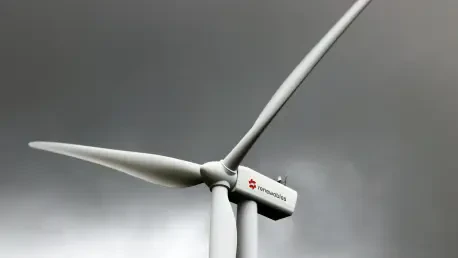Imagine a world where the towering blades of wind turbines, essential for harnessing renewable energy, are no longer constrained by the limitations of ground transportation, allowing for unprecedented growth in onshore wind power and transforming the landscape of sustainable energy. In the realm of renewable energy, logistical challenges have long hindered the scalability of onshore wind farms, primarily due to the difficulty of transporting oversized turbine blades to remote locations. Current constraints limit these blades to around 70 meters in length, far shorter than their offshore counterparts, which often exceed 100 meters. This disparity directly impacts the economic efficiency of onshore wind projects. Enter the WindRunner project, an ambitious initiative by startup Radia, which aims to shatter these barriers with the development of the world’s largest airplane designed specifically for heavy cargo transport. This groundbreaking concept could potentially transform the landscape of renewable energy by enabling the deployment of larger, more efficient turbines across diverse terrains.
Breaking Barriers in Wind Turbine Logistics
The WindRunner aircraft, envisioned by Radia, represents a monumental leap in addressing the transportation bottleneck for onshore wind energy components. With dimensions that defy conventional aviation standards, this colossal plane stretches 108 meters in length and boasts an 80-meter wingspan. Its cargo hold, reportedly six times larger than that of the legendary An-225 “Mriya,” is engineered to accommodate up to three 80-meter blades or a single 105-meter blade, with a payload capacity of 72.5 tons. Beyond sheer size, the aircraft’s design includes a massive straight wing, enabling takeoffs and landings on short, semi-prepared dirt runways as brief as 1,800 meters. This feature significantly enhances accessibility to remote wind farm sites, often located far from major infrastructure. The ability to operate within a 2,000-kilometer flight range also positions WindRunner as a viable solution for regional transport across continents like North America and Europe, potentially unlocking new opportunities for wind energy expansion in previously inaccessible areas.
Moreover, the implications of WindRunner extend beyond mere transportation logistics, promising a shift in how onshore wind projects are planned and executed. By facilitating the delivery of larger blades, the aircraft could drive down the cost per megawatt of energy produced, as bigger turbines typically offer greater efficiency. This could make onshore wind a more competitive alternative to other renewable sources, accelerating the transition to cleaner energy grids. Radia’s vision, rooted in overcoming a critical industry challenge, also considers the environmental footprint of such massive transport operations. While the specifics of fuel efficiency and emissions remain under wraps, the potential to reduce reliance on lengthy, fuel-intensive ground transport routes offers a compelling case for sustainability. As the renewable energy sector continues to grapple with scaling challenges, WindRunner stands as a bold proposition that could redefine the economic and operational dynamics of wind farm development.
Challenges and Skepticism Surrounding the Project
Despite the transformative potential of WindRunner, significant hurdles cast a shadow over its realization, with industry skepticism focusing on Radia’s inexperience in aircraft manufacturing. Founded in 2016 by aerospace engineer Mark Lundstrom, the startup lacks the established track record of traditional aviation giants, raising questions about its capacity to execute such an ambitious endeavor. The financial investment required for development and production is staggering, and without substantial backing, experts doubt the project’s feasibility. However, Radia has taken steps to mitigate these concerns by partnering with experienced suppliers from countries like Italy, Spain, and the USA. Additionally, the selection of a certified engine, though not yet publicly disclosed, signals progress in addressing technical challenges. The decision to pursue a fixed-wing design over alternatives like airships reflects a pragmatic approach, avoiding regulatory and infrastructure complications that could further delay development.
Adding to the complexity, the timeline for WindRunner’s rollout remains uncertain, with only small-scale wind tunnel tests completed so far and full-scale test flights planned for the end of the decade. Serial production, a critical step for widespread adoption, is even further on the horizon, contingent on overcoming both technical and financial obstacles. Beyond the primary mission of wind turbine transport, interest from the defense sector, including a recent contract with the U.S. Department of Defense, suggests alternative applications that could diversify funding sources. Yet, this also raises questions about whether such diversions might dilute focus from the core objective of supporting renewable energy. As Radia navigates these multifaceted challenges, the balance between innovation and practical execution remains delicate. The industry watches closely, weighing the promise of a logistics revolution against the very real risks of overambition in an untested venture.
Paving the Way for Renewable Energy Innovation
Reflecting on the journey of WindRunner, it becomes clear that Radia is tackling an immense challenge with a vision that blends audacious engineering with a commitment to renewable energy advancement. The project stands as a testament to the power of innovative thinking in confronting long-standing industry bottlenecks. Despite facing skepticism and financial uncertainties, the strides made in design and partnerships underscore a determination to push boundaries. Each step, from wind tunnel testing to securing defense contracts, marks a calculated effort to build credibility and momentum in a field dominated by established players.
Looking ahead, the path for WindRunner demands strategic focus on securing robust investment to bridge the gap between concept and reality. Collaborations with industry leaders and policymakers could accelerate development, ensuring that logistical innovations align with global renewable energy goals. As full-scale testing approaches, transparency in addressing technical challenges will be vital to maintaining stakeholder trust. Ultimately, the success of this endeavor hinges on transforming visionary ideas into tangible solutions, potentially setting a new standard for how renewable energy infrastructure expands across challenging landscapes.









